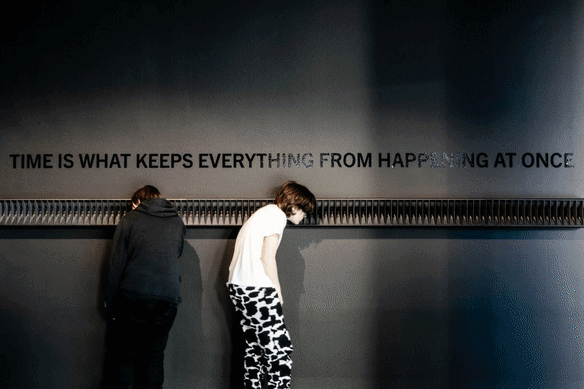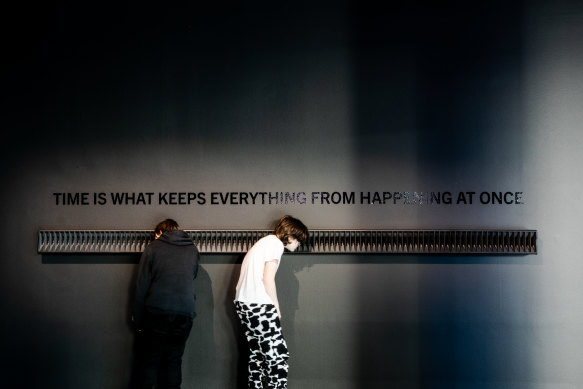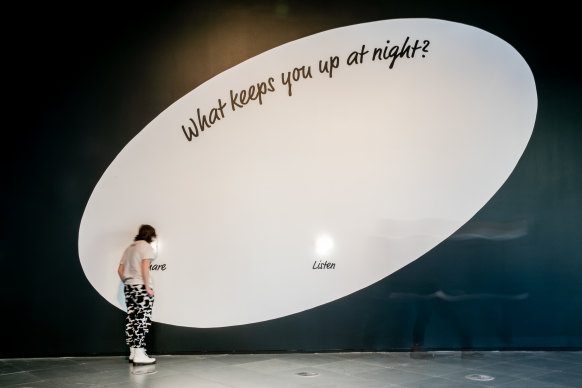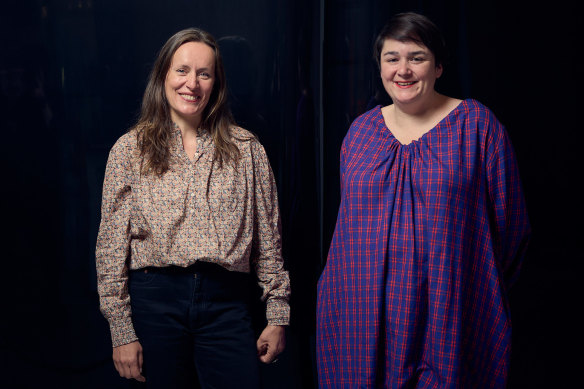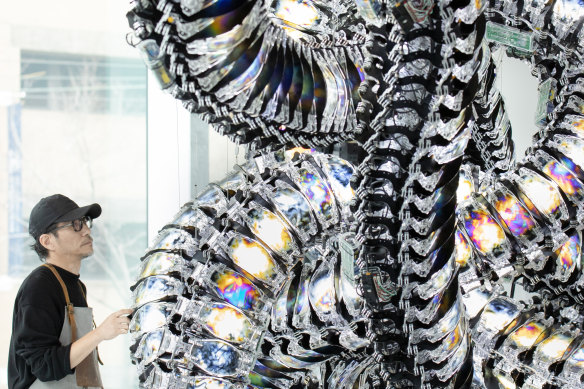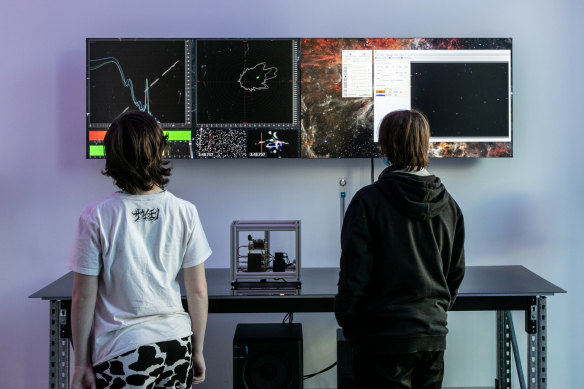By Sonia Harford
Credit: Science Gallery
Save articles for later
Add articles to your saved list and come back to them any time.
We may be a highly evolved species, but even the finest scientific minds are still groping in the dark for answers to the planet’s most perplexing questions – and occasionally cursing the fact that they remain elusive.
“Every once in a while you think holy f—, what else is happening out there that we can’t yet see?” asks physicist John Ellis in The View from Nowhere, a short film about the extraordinary CERN laboratory in Switzerland.
Scientists speak about CERN the way most people speak about going to the Coachella music festival; it’s the coolest thing in their world. The View from Nowhere is one of the drawcards of the exhibition Dark Matters, a collaboration between Melbourne’s Science Gallery and CERN’s arts program.
Cursing in the most plummy of British accents, Ellis pinpoints just how much we don’t know about our galaxy. CERN’s vast international workforce is dedicated to finding out what we can’t see. Aiding them in the endeavour is a 27-kilometre ring of superconducting magnets that sits beneath CERN’s Geneva headquarters. The Large Hadron Collider is helping scientists to answer some of physics’ great unknowns, including the deep structure of space and time.
Visitors experience TIME TO X by David Hochgatterer.Credit: Alan Weelan
The film itself is exquisitely shot, with gargantuan pieces of equipment and shiny sculptural forms. It’s a useful gateway into the exhibition as a whole, an artistic response that makes the material lively and accessible.
The Science Gallery has wisely called the exhibition Dark Matters, plural, to welcome those not versed in particle physics. Given dark matter is invisible and seems unknowable, the exhibition interprets darkness very broadly as a metaphor. Take magic, for example.
One of the installations, Mystery Box, unites comedian Lawrence Leung, magician Dom Chambers and doctor Vyom Sharma in weekly performances, or “activations”, in which visitors guess what is inside a box the gallery calls an “arcane aquarium”. As co-curator Tilly Boleyn teases: “Even when we have something in front of us, it can be invisible to us.”
Night Exchange explores the thoughts that keep us up at night, with visitors whispering their private fears into a 3D-printed ear. Further along the wall a 3D-printed mouth responds with the fears of others: “I’m worried about identity theft” or “what will I do if I get pregnant?” The responses were generated by a sister science gallery in India.
A visitor experiences Night Exchange by Random Quark.Credit: Eugene Hyland
A definition of dark matter will at some point be inevitable. But staying with the metaphor is a more gentle run-up for the average artist and gallery visitor. Monica Bello, head of arts at CERN, knows this well.
“We are not expecting artists to become experts in particle physics. In fact, the merging of knowledge is what is interesting for us. Dark matter is a very powerful metaphor. We’re all intrigued by the invisible. Dark matter gives room to imagine and dream and to employ this as a nice analogy.”
CERN began an arts program and artists’ residencies in the belief that art and science are inextricably linked, she says.
“Both are about creativity, both require technical mastery, both are about exploring the limits of human potential. Creating silos of knowledge is not useful for society and that is what many of us share at CERN. We are the largest scientific community, I think, in the world, more than 12,000 people, and there is a growing understanding that science is culture.”
The Science Gallery shares that charter – and is part of a global network of institutions teaming art and science to demystify and intrigue.
Monica Bello, left, and Tilly Boleyn inside the Science Gallery’s Dark Matters exhibition.Credit: Eugene Hyland
It does seem that science communicators are getting better at explaining the theoretical. Think of Brian Cox on TV and films such as Oppenheimer and Interstellar. With characters’ lives at stake, nuclear energy and black holes are suddenly a lot more riveting.
Yet it has to be said that dark matter, which is believed to make up 95 per cent of our universe, still poses quite the challenge for communicators. It doesn’t emit, absorb or reflect light. Scientists worldwide are sharing the quest to know more, including those working inside a former gold mine a kilometre underground in Stawell.
In a bid to throw light on the subject, some of the sculptures, screens and lab equipment inside Dark Matters generate excitement when subatomic particles are detected – when lights and sounds make the invisible visible.
“Subatomic particles are streaming down from the cosmos every moment of every day,” says Boleyn. “They rain down on the Earth, passing straight through us and the Earth and none of us notice at all.”
The detection of particles gets them noticed. One of the largest works in the exhibition is a kinetic sculpture, Chroma V, created by Korean artist Yunchul Kim. Kim’s 10-metre-long serpent is twisted in knots, with hundreds of reflective sections. The creature throbs when it detects subatomic particles.
Artist Yunchul Kim with his Chroma V sculpture.Credit: Simon Schluter
“It’s translating the frequency of those particles hitting the detector into something that is visible for us,” says Boleyn.
In Jon Butt’s work, µ Muography, a sensor blips every time it detects a muon, a type of subatomic particle. Using this detection, Butt is composing music with the cosmos.
Visitors to µ Muography by Jon Butt.Credit: Alan Weedon
Other works carry lively titles such as Ionize Ionize!, which illuminates materials called “scintillators”. The fluorescent effect that occurs when they’re exposed to radiation is familiar to anyone who has ever passed through an airport scanner or undergone radiation therapy.
In Time To X, by Austrian audio installation artist David Hochgatterer, the sentence “Time is what keeps everything from happening at once” is broken into fragments, which are played from 96 speakers. Exhibition visitors can use their own movement to travel through time or hold it still. “Lean in, ear to the wall, and let time stretch to your own measure,” the gallery website urges. “Will you listen to everything at once, or take it one fragment at a time?”
Dark Matters goes deep for those who are familiar with the science, and shiny and playful for those who aren’t. Ultimately, Bello urges a relaxed approach to whatever we can’t comprehend. “What intrigues you and makes you want to know more? It doesn’t mean you will understand everything.” The clue is in the wondering.
Dark Matters is at the Science Gallery, University of Melbourne, until December 2. The next Magic Box activation is on Saturday, September 30, at 12:15pm.
Most Viewed in Culture
Source: Read Full Article
